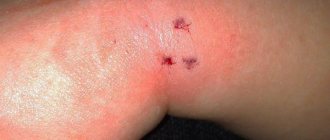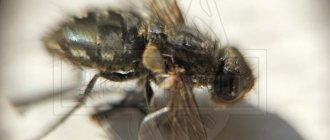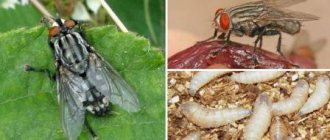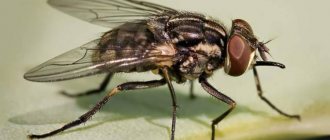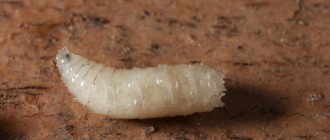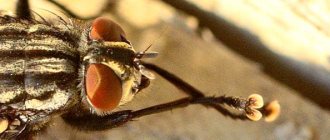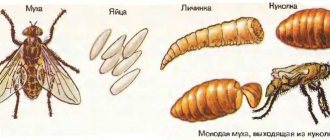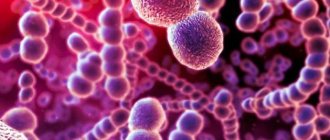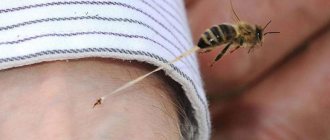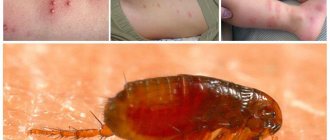As summer begins to wind down, in August and early fall, “the flies become aggressive and angry.” Is this statement true, and are all these insects really starting to behave so bloodthirsty for some reason?
In fact, it is difficult to imagine an insect capable of experiencing emotions characteristic of humans, including anger. But what then makes flies attack people in order to feed on blood at the end of summer - beginning of autumn, and how true is the myth about their increasing aggression during this cool time?
What flies can bite and how to distinguish biting flies from harmless ones?
There are about 5,000 species of flies all over the world, and each species differs from the other in color, size, body structure and many other characteristics. In nature there are flies that feed exclusively on liquid plant food. This is due to the presence of a soft proboscis that is not capable of biting through the skin. Therefore, such flies are forced to feed on manure, feces, plant sap, and so on.
However, there are other flies, for example, such as the zhigalka . It differs from an ordinary housefly, firstly, in the structure of its proboscis, its proboscis is much longer, and it also has special bristles at the end, the proboscis itself is hard, thanks to which the live fly is able to pierce the top layer of skin - the epidermis - and drink blood. Secondly, it is also worth noting that another important difference is the structure of the wings. In the house fly they are located along the body, and the wings of the burner fly look to the sides. On average, the size of the gray body of fireweeds is 7 mm.
During the summer period, females lay eggs, and burners are very fertile. Over the course of her entire life, one female can lay up to 400 eggs. A week after the female has laid her eggs, the eggs hatch into larvae that have a slightly white-dirty hue. After 3-4 weeks, the larvae turn into pupae and literally after 27 days the pupae produce a young zhigalka. In turn, the young zhigalka, literally after 15 days of its formation, also lays eggs, like other adult female zhigalkas.
It turns out that during the summer the flies actively reproduce, the younger generation grows up, and in the fall their numbers become larger , at least very noticeable even for us.
It is noteworthy that if in mosquitoes, for example, only females bite, in mosquitoes both male and female take part in this.
Most often, live flies attack animals, but they do not mind feeding on human blood. Light flies prefer to attack people who are sedentary, that is, the elderly, the disabled and even infants.
Ways to fight
How to fight these predators? Of course, it is best to put mosquito nets, traps, sticky tapes on the windows, close the door constantly or hang curtains. You can't get rid of them so easily with just a fly swatter. However, these methods are suitable for small living spaces.
But on an industrial scale and on farms, they fight burners in more serious ways:
- mechanical;
- chemical;
- biological.
The first includes all kinds of barriers on windows and ventilation openings (including mosquito nets, as well as various types of traps). These methods help get rid of adults that bite.
Chemical preparations - insecticides - even get rid of fly larvae. These products are used on farm premises; they are used to treat manure heaps, as well as livestock stalls.
Also popular today are biological types of defense, in the role of which are entomophagous insects - they eat fireflies and their offspring. Thanks to these parasites, the population of predatory flies will rapidly decrease.
Why do flies bite?
Why do flies bite? The answer was partially given in the previous paragraph: by August their population becomes larger, competition for food becomes stronger, so the flies switch from feeding on animal blood to human blood.
In fact, some species of flies need blood to reproduce. This is the simplest and most logical explanation. They anticipate the approach of cold weather and begin to bite everyone in a row, just to have time to get enough and reproduce new offspring.
In the spring, flies just appear, biting flies begin to lay eggs, in the summer, young individuals form, and closer to autumn they become adults, capable of independent existence. Therefore, in the fall there are so many of them that they have to compete with each other in search of prey.
Curious speculations and facts
In addition to scientifically proven facts, there are also various assumptions regarding why flies pester people. For example, some believe that the human aura attracts annoying insects. The more negative it is, the more flies will attack its owner. Others are confident that dipteran hunters choose only negative individuals as “victims” and ignore positive ones.
There is also a theory that flies cannot distinguish between a living organism and an inanimate object. But scientists have proven that this is not true. Insects are much smarter than they are thought to be. For this reason, huge blowflies (except in the autumn period) ignore people and only annoy people with rotten pieces of meat and animal corpses. Vegetarian flies, for which human skin serves as a source of food, will never confuse it, for example, with a kitchen table.
Is a fly bite dangerous for humans?
The bite of flies is dangerous , since these flies can be carriers of various terrible diseases, such as polio, anthrax, tuberculosis, relapsing fever and many others. During a bite, penetrating the skin with their proboscis, flies emit poisonous saliva, thereby, in addition to the pain from the bite, we also feel itching, burning, and the skin turns red at the site of the bite.
However, not only the bite of the flies itself is dangerous; if basic hygiene rules are not observed while eating, the larvae of these flies can enter our body along with food.
Spreaders of diseases
During their bites, flies can transmit such terrible diseases as cholera and tuberculosis to the victim. Intestinal diseases of various forms, viral infections - this is just a short list of all the diseases that an ordinary fly can carry on its legs and trunk. By infecting sick animals, they are the first distributors of helminths, lamblia and other parasites.
Blood-sucking flies are the first among the distributors and carriers of eye infections, such as infectious conjunctivitis, trachoma, etc. When they bite a person with polio and bite the next victim, the parasites spread this virus for a long time.
Horseflies
Also one of the most biting types of flies are horseflies. They come in several colors: brown, yellow and gray. The size of their bodies reaches 3 cm.
These flies, as a rule, live near water bodies and swamps, since they cannot exist without moisture. The habitat of horseflies is located on almost all continents of planet Earth, with the exception of Antarctica, Greenland, and Iceland. These blood-sucking insects most often attack cattle and people. If in the first case, both males and females drink blood from live fly flies, then in horseflies, only females ; males prefer plant food.
The bite is so painful, that is, even people with normal skin type immediately experience itching, pain, burning and redness at the site of the bite. They say that there were cases when, after being attacked by a large number of horseflies at once, people ended up in intensive care due to lack of blood. Most likely this is fiction.
If we compare the amount of blood that a horsefly and a mosquito can drink, then one horsefly is capable of pumping into its body a volume of blood equal to the volume of 70 mosquitoes.
The horsefly, like other flies, is dangerous, not so much because it drinks blood from animals and people, but because during its bite it also throws out its saliva. Its saliva contains various toxic components, which cause skin irritation. But that’s not even the point, their saliva can also contain various bacteria that give rise to such terrible diseases as anthrax, polio and many others.
Therefore, it is recommended that in order to minimize the possibility of saliva penetration, it is necessary to apply pressure to the bite site; in case of redness or burning, it is necessary to apply a piece of ice.
How to protect your home
Many plants have a scent and secrete special enzymes that repel these insects. At your summer cottage, it is good to plant bushes of bird cherry, currant, and black elderberry under the windows ; these bushes will provide environmental protection to the house and flies will fly around it. Bouquets of the following herbs are also used :
- succession leaves;
- celandine;
- St. John's wort.
For apartments, the most suitable are geranium and tansy . By placing several pots with these plants on the windowsill, you can secure your apartment; bloodsuckers will not fly in and bite. In addition, geranium helps to significantly reduce the likelihood of mosquitoes, beetles, and ticks; these insects, which are also often annoying in the summer, cannot tolerate the smell of geranium.
An insect repeller can be installed in apartments; an ultrasonic device produces a low-frequency sound that is not audible to the human ear, but is well recognized by insects as a danger signal.
Keeping garbage cans, waste storage containers clean, and preventive treatment of cesspools in a summer cottage will ensure a significant reduction in the number of parasites, and as a result, the comfort of the home.
Tsetse fly
One of the most dangerous types of flies on Earth are Tsetse flies. Their habitat is in Africa. Tsetse are deadly.
It is noteworthy that these flies are viviparous, that is, they give birth to an already viable larva.
The tsetse fly is dangerous because it is a carrier of trypanosomes that parasitize the blood of humans and animals. When it gets into the blood, it has a destructive effect: a person’s immune and nervous systems weaken, various tumors appear, and in general the person weakens, which is why this disease is also called sleeping sickness.
Prevention
It is very short and without innovations. At home, do not forget to use mosquito nets on the windows. And on the street, and especially during country house maneuvers, you should use special bloodsucker-repellent sprays and not yawn.
OUR READERS RECOMMEND!
To get rid of insects, our readers recommend the Pest-Reject repeller
. The operation of the device is based on the technology of electromagnetic pulses and ultrasonic waves! Absolutely safe, environmentally friendly product for humans and pets. Read more here...
How to treat?
- The bite site should be thoroughly washed with soap, poured with peroxide or wiped with alcohol; as a rule, this is enough to disinfect the bite.
- If swelling appears at the site of the bite, it is recommended to make a compress from pieces of ice.
- If itching occurs, you must use a special anti-itch cream.
- If the itching does not go away and the redness increases, take an antihistamine, it will relieve allergy symptoms.
- Monitor the damaged area of skin and general condition. If the wound begins to fester or swelling does not go away, consult a doctor.
Typically, a fly bite will heal within 1-2 days if you do not scratch it.
First aid
Multiple injuries are the most painful: if a fly bites the legs, arms, stomach and other parts of the body, inflammation develops. The bite causes soft tissues to swell and overall health may deteriorate. Bite wounds are treated with an antiseptic: bright green, alcohol, iodine.
In this case, non-alcoholic products will help: chlorhexidine, hydrogen peroxide. In addition, with one bite, soothing and refreshing ointments help, reducing the manifestations of local reactions. To prevent fly bites from causing allergies in children, children are prescribed Zodak drops or Diazolin for children.”
The danger posed by gadflies
The gadfly is another species of fly dangerous to humans. These insects live mainly near animal pastures, since they are their main target. Unlike their biting relatives, they do not feed on the blood of other creatures. Moreover, scientists have recently discovered that adults do not need food at all. The reserves they acquired while at the larval stage are quite enough for them.
However, a completely justified question arises: why do they bite animals? The fact is that when they bite, they lay their eggs under the skin of the victim, thereby providing them with an excellent source of food. Let's be honest, after the larvae hatch from the eggs, the poor animal experiences terrible pain, as they literally eat his body from the inside.
But the main danger is that gadflies can lay their eggs on human skin. Even if this happens rarely, the consequences of this accident are extremely sad. After all, the only reliable way to get rid of larvae is to partially remove the infected area of flesh.
